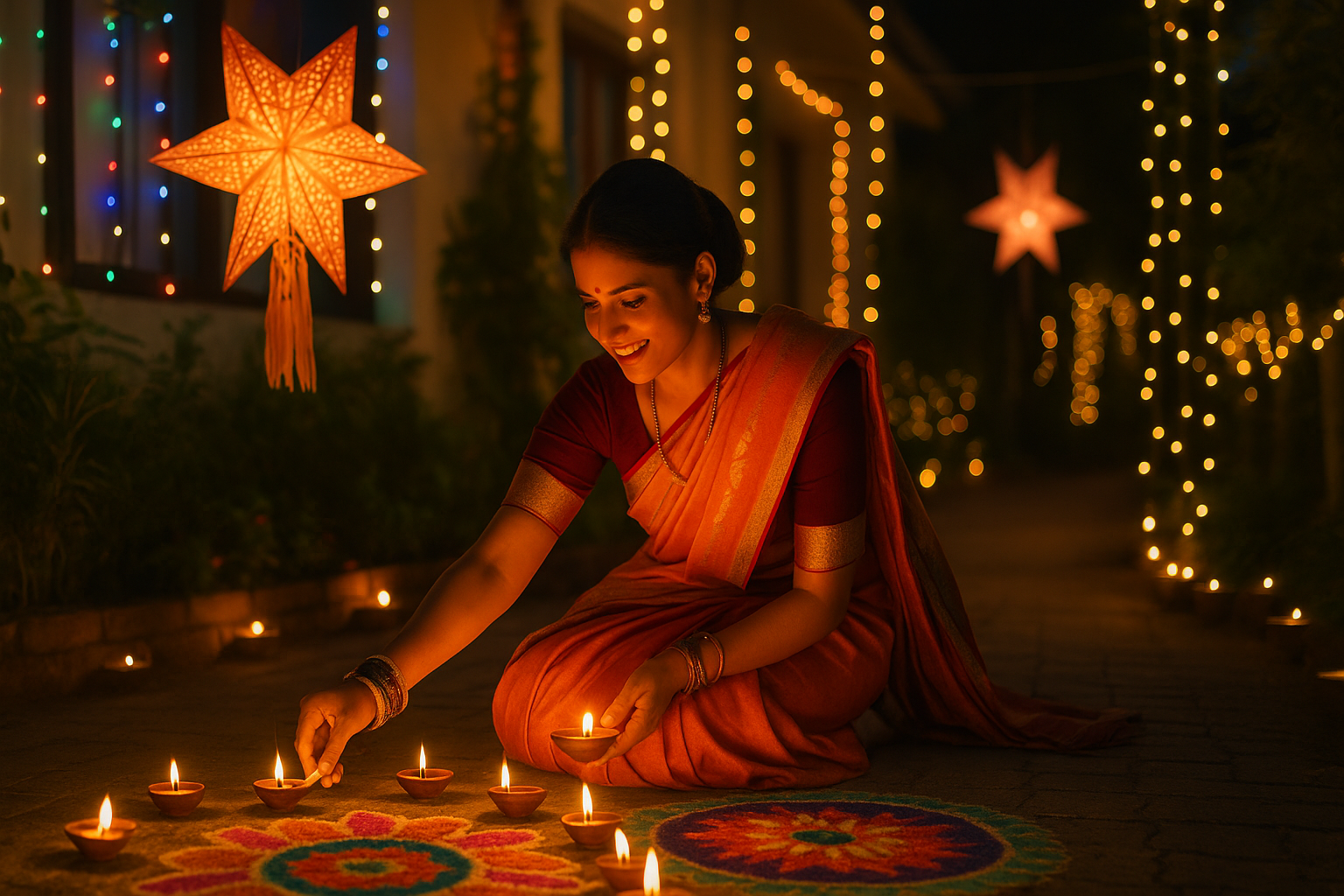
PANAJI
As the grand festival of lights, Deepavali (row of lamps) or Diwali, approaches, excitement fills the air. The festival brings eagerness, joy, and togetherness, lighting up Hindu homes not only across India but also around the world. Diwali falls on the darkest night of the year — the 15th day of the month of Kartik (Amavasya or no-moon day). It is celebrated with beautiful illumination as earthen diyas, akash kandils and electric lights brighten temples, homes, offices, shops and streets.
Before Diwali, homes are thoroughly cleaned and often repainted. Families work together to decorate their spaces with akash kandils (sky lanterns), flowers, rangoli and clay diyas, filling the home with fragrance, colour and light. Goans too have begun preparations and planning for a grand celebration this year. The muhurats (auspicious timings) for each ritual are carefully noted and followed for the five days of festivities, beginning with Vasubaras. While many start with Dhantrayodashi (Dhanteras), the first day of Diwali actually begins with Vasubaras, dedicated to worshipping cattle.
According to the Hindu Panchang, Ashwin Krishna Dwadashi — also called Govats Dwadashi — is observed as Vasubaras. This year, it falls on Friday, October 17, when the Dwadashi tithi begins at 11:12 am and ends on October 18 at 12:18 pm. The pradoshkal muhurat between 4:14 pm and 7:43 pm on October 17 is considered the most auspicious time for cow worship.
The cow is regarded as sacred because, according to ancient scriptures, the 33 categories of deities are believed to reside in her. Worshipping Gomata (the cow) is an age-old tradition, and even Lord Krishna proudly called himself Gopala — the protector of cows. Godaan (donating a cow) is said to be the highest form of charity, while the Pancha Gavya (five sacred products from the cow) — milk, curds, ghee, cow dung and gomutra — are considered holy.
“There is a reason why the cow is worshipped — to invite Goddess Lakshmi, the goddess of wealth and prosperity, into our homes. Vasu means wealth, and baras means Dwadashi. Women fast on this day,” explains Vasanti Gaonkar, a homemaker from Valpoi. Families who own cattle prepare a special meal of puran for the cow, and women end their fast with bajra roti and gawar bhaji. Wheat, moong, milk and milk products are avoided as a humble tribute to the cow. Fried or roasted food is also not prepared, and colourful rangolis decorate the entrances of homes.
The next day is Dhantrayodashi (Dhanteras), observed on the Trayodashi tithi of Krishna Paksha, when Goddess Lakshmi and Lord Kubera — deities of wealth and prosperity — are worshipped. According to the Drik Panchang, Goddess Lakshmi emerged from the ocean during the churning of the Milky Sea on this day. “We buy something new — utensils, gold, jewellery, property or a vehicle — as it is believed to bring prosperity,” says Ashwini Raikar. Laxmi Pujan is performed in the evening at homes and business establishments to welcome the goddess and Lord Kubera.
This year, Kartik Krishna Trayodashi begins on October 18 at 12:18 pm and ends on October 19 at 1:51 pm. Hence, Dhanteras will be celebrated on Saturday, October 18, based on the pradosh muhurat.
Narak Chaturdashi, or Chhoti Diwali, follows and marks Lord Krishna’s victory over the demon Narakasura. In Goa, children and youth create large effigies of Narakasura and parade them through the streets, depicting the battle between Krishna and the demon. Competitions are held across towns, drawing huge crowds. Interestingly, the most fearsome and grotesque effigy usually wins the prize — a contrast to most other beauty-based contests.
Diwali also celebrates Lord Rama, Mata Sita and Lakshman’s return to Ayodhya, symbolising the victory of good over evil. Homes are lit with earthen lamps, decorated with rangoli and filled with light. Lord Krishna and Lord Rama are both remembered with devotion during the Goan Diwali celebrations. The festival also includes Govardhan Puja, which honours Govardhan Parvat, the mountain Lord Krishna lifted to protect the people of Mathura from Lord Indra’s wrath. The elderly often share these timeless stories with the younger generation.
The final day, Bhai Dooj (also called Bhau Beej or Bhaiya Dooj), celebrates the bond between brothers and sisters. Sisters perform aarti for their brothers and exchange sweets and gifts. Married sisters are visited by their brothers, who bring them presents.
On this day, earthen lamps are also lit for Yama, the god of death, during the pradosh period — the auspicious time after sunset. This year, Yama Deepam is to be lit between 5:48 pm and 8:20 pm, with diyas placed outside the house in the southern direction to protect family members from untimely death.
Each year, Diwali fills hearts with joy and homes with light, leaving memories to cherish. Loved and celebrated by all, the festival truly brings brightness and warmth into our lives.
Happy Diwali!